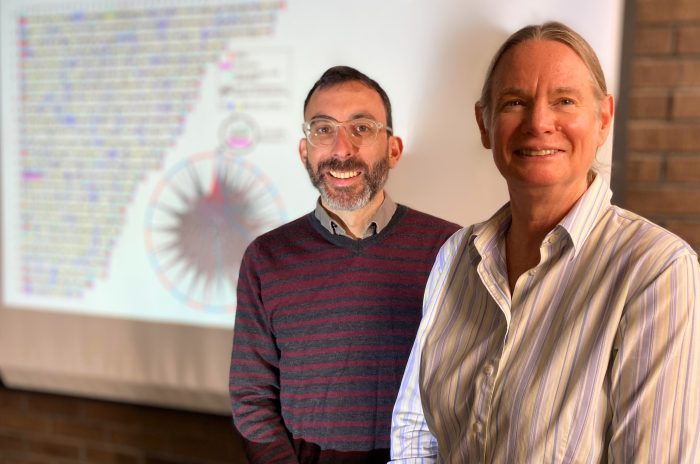SBU’s Jackie Collier, Joshua Rest solve genetic mystery in marine protist

By Daniel Dunaief
They were trying for two years to solve a puzzle that didn’t make sense. Then, a combination of another discovery, some extensive analysis, and a deep dive into the past helped them put the pieces together.
Jackie Collier, Associate Professor at the School of Marine and Atmospheric Sciences at Stony Brook University and Joshua Rest, also an Associate Professor in the Department of Ecology and Evolution at Stony Brook, had been looking closely at the genetic sequence of a marine protist called Aurantiochytrium limacinum. A circular section and pieces at the end of the chromosome seemed inconsistent with the rest of the genes and with the specific type of single-celled organism.
But then, they saw a preprint of a paper in 2022 that the prestigious journal Nature published earlier this year that described a new type of virus, called a mirusvirus, which appeared to have genetic similarities and a signature that matched what they saw in their protist.
Mirus means “strange” or unknown in Latin, which was a way to describe the unusual evolutionary traits of these viruses.
Collier and Rest, working with a group of collaborators, found that a high copy circular structure and genetic elements that integrated at the end of one chromosome resembled this mirusvirus.
“From the perspective of the virus folks, ‘mirus’ was apt because the mirusviruses contain features of the two very distinct ‘realms’ of viral diversity,” Collier explained. “Our results confirm that strangeness, and add more strangeness in terms of two different ways to maintain themselves (circular episomes or integrated into a chromosome) in the same host genome.”
Researchers had discovered the mirusvirus by sequencing DNA they took from the ocean. “What our findings do is connect to a host and hopefully eventually prove that there is a protist that contains a mirusvirus genome,” said Collier.
The Aurantiiochytrium protist, which is part of the Thraustochytrids order, intrigues researchers in part because it produces essential omega-3 fatty acids and carotenoids, which enhances its biotechnology potential. This protist also intrigues Collier because it is involved in decomposing dead mangrove leaves in mangrove forests.
Dormant virus
The Stony Brook scientists have been working on analyzing the genome for a paper they recently published in the journal Current Biology since 2019.
“We had been struggling to figure out what that was,” said Collier. “We had a lot of hints that it had some relationship to some kind of viruses, but it wasn’t similar enough to any known virus. We were struggling to figure out what to call this thing,” which they had tentatively designated CE1, for circular element one.
Identifying viral elements provided the “hook” for the paper.
Rest suggested that the different confounding elements in the protist genome came from two different viruses.
At this point, Collier and Rest think the virus may be something like the herpesvirus, which hides out in human nerve cells. That virus enters a latent phase, remaining quiescent until a host becomes stressed.
John Archibald, Lucie Gallot-Lavallee and others from Dalhousie University in Canada, who are collaborators on this study, are creating the kind of conditions, such as lower food or colder temperatures, that might reactivate the viral DNA, causing it to release viral particles.
The research team has detected similar mirusvirus proteins in other Aurantiochytrium isolates and in four other Thraustochytrid genomes.
Focusing on this protist
Collier started working on thraustochytrids in 2002, after the first outbreak of QPX disease in Raritan Bay hard clams.
Bassem Allam, who is now the Marinetics Endowed professor in Marine Sciences at SBU asked Collier if she would help understand what was going on with the clams which had QPX disease. That was caused by another Thraustochytrid.
The organism that caused QPX is a relative of the protist that interested Collier. She chose Aurantiochytrium in part because it was the easiest to grow.
When the Gordon and Betty Moore Foundation started a program to develop molecular genetic methods for diverse marine protists about seven years ago, Collier approached Rest for a potential collaboration.
A key piece, half a century old
In her informatics work, Collier followed a path that Google or artificial intelligence might otherwise have missed.
Like traveling back hand over hand in time through older research, Collier pulled up the references from one study after another. Finally, she found an intriguing study from 1972 that had overlaps with their work.
Scientists had isolated a Thraustochytrid from an estuary in Virginia using the same kinds of methods Collier and Rest used to grow Aurantiochytrium. Using electron microscopy, these earlier researchers characterized its ultrastructure. Along the way, these 1970’s scientists noticed that starved cells released viral particles, which Collier and Rest believe might be the first record of a mirusvirus.
The researchers wrote a short paper that the prestigious journal Science published.
A cat connection
While Collier, who lives in Lake Grove, and Rest, who is a resident of Port Jefferson, are collaborators at Stony Brook, they have also have a feline connection.
In the beginning of the pandemic, a feral cat delivered kittens in Rest’s garage. Rest’s family initially tried to raise them, but allergies made such a pet arrangement untenable.
A cat lover, Collier was searching for kittens. She adopted two of the kittens, bottle feeding them starting at three days old. When Collier and Rest speak by zoom, Rest’s children Julia, nine, and Jonah, five, visit with the cats virtually.
As for their work, Collier and Rest are intrigued by the possibility of gathering additional pieces to answer questions about this virus.
“For me, the most intriguing question is how common our observations will turn out to be — do many Thraustochytrids have latent mirusviruses?” she explained.






